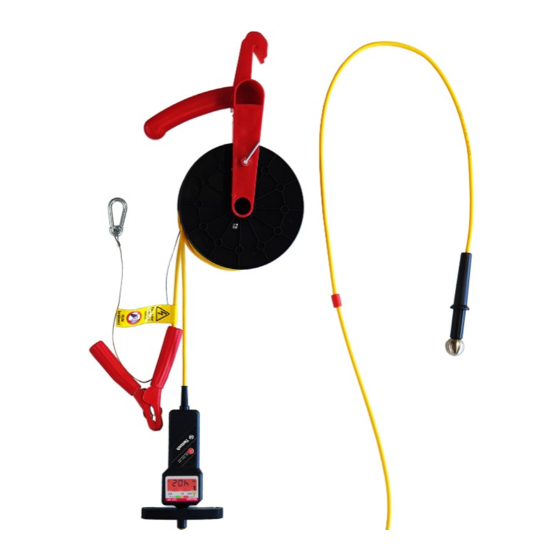Summary of Contents for Tietzsch MultiSafe DSP-HW 2
- Page 1 User Instructions MultiSafe DSP-HW 2 Voltage warning device for flooded electrical systems Rudolph Tietzsch GmbH & Co. KG Willringhauser Straße 18 58256 Ennepetal GERMANY Telefon: +49 2333-75989 info@tietzsch.de www.tietzsch.de DSP-HW2_BA_03-2021...
-
Page 2: Symbols On The Instrument
TR on On-time at highest nominal voltage This device has to be disposed of according to the appli- cable regulations and laws (for Europe: WEEE 2012/19/EU). Please contact service@tietzsch.de in regard to the return Do not touch! of old devices. - Page 3 The MultiSafe DSP-HW 2 is a voltage warning device for the detection of dangerous voltages from 25 V AC / 40 V DC to 1000 V AC / 1500 V DC in water or similar conductive liquids.
- Page 4 1.3 Check while installing / removing pumps The water can be checked for voltage before and during the installation / removal of a pump in the flooded area. This means that the pump can be safely inserted into or removed from the water. 1.4 Checking flooded maintenance shafts In the case of flooded maintenance shafts, the ball electrode can be lowered into the water and this can be checked for voltage.
- Page 5 practical exercise with the device The documents for the training can be found at: www.tietzsch.de The authorization by the responsible manager must be documented. It must be checked annually whether the instructions are being followed and work is being carried...
- Page 6 2. Safety precautions In order to maintain the safety-related faultless condition and to ensure safe use, it is essential that you read these operating instructions completely before using your device and that you follow them in all points, otherwise there is a risk to life! Please note the following safety precautions: Before work on a flooded area, the responsible energy supplier / electricity network operator must be informed and the flooded area must be switched off /...
- Page 7 The voltage specifications on the DSP-HW 2 are nominal values. The voltage warning device may only be used in systems up to a maximum of 1000 V AC / 1500 V DC. The permitted temperature range for use is - 15 ° C to + 55 ° C. The permissible duty cycle is 2 minutes at 1000 V AC / 1500 V DC.
- Page 8 3. Commissioning, earthing and self-test 3.1 Unwind the grounding line Loosen the lock on the drum and unroll the cable completely or so far that the test point can be easily reached from the earthing point. Note: For quick operation, both ends of the cable (test device and clamp) are unwound from the drum at the same time and are fixed in the middle (at 15 m).
- Page 9 3.3 Secure earthing Secure the clamp against being pulled off! Use the safety rope for this. The grounding clamp for the earth connection can be live during the test! The risk of electric shock is prevented by the protective elements in the device. 3.4 Self-test The self-test checks the function of the voltage warning device, the line and the ground connection.
- Page 10 4. Testing voltage Do not touch the water or objects protruding into the water (e.g. banisters)! These parts can be live! Do not touch the water even after it has been determined to be free of voltage! Dangers can arise at any time due to changing water levels. 4.1 Display LEDs off green LEDs flash...
- Page 11 4.3 Check banisters Only grasp the handgrip with the ball electrode by its handle. Use the ball electrode to touch the banisters and other conductive objects that may protrude into the water and check for voltage. No voltage detected No voltage Voltage present! Danger! Do not touch the banisters!
- Page 12 4.4 Test water Only touch the DSP-HW 2 by the handle of the display unit and in the hand area of the handle cable. Lower the handle with the ball electrode into the water. Note! The red limiting mark indicates the maximum test radius. Do not sink this into the water in order to identify the test radius.
- Page 13 4.5 Test water and setup pump Only touch the DSP-HW 2 by the handle of the display unit and in the hand area of the handle cable. Lower the handle with the ball electrode into the water. Place the display outside of the water so that the LEDs are clearly visible. Note! The red limiting mark indicates the maximum test radius.
- Page 14 4.6 Absorption of residual water Attention! This working method may only be used after the water level has dropped to a few centimeters and pumping from the edge is no longer possible. It must be ensured that no more water flows in. Note! The red limiting mark indicates the maximum test radius.
- Page 15 Repair is only allowed by the manufacturer or explicitly authorised repair shops. In case of damages on the device or failure of the function test or for detailed inspection/calibration, please contact: service@tietzsch.de or send the device and a description of failure back to the manufacturer. 8. Maintenance / Storage The DSP-HW 2 is absolutely mainteinance-free.
- Page 16 9. Technical data MultiSafe DSP-HW 2 Voltage warning device Standards: BG requirements „Spannungswarner Wasser“ GS-ET-43 based on EN/IEC 61243-3:2014 + Cor.: 2015 DIN VDE 0100-410 (IEC 60364-4-41) „Schutzmaßnahmen - Schutz gegen elektischen Schlag“ für Spannungsgrenzen Fire brigade accident prevention regulations GUV-V C53...


















Need help?
Do you have a question about the MultiSafe DSP-HW 2 and is the answer not in the manual?
Questions and answers